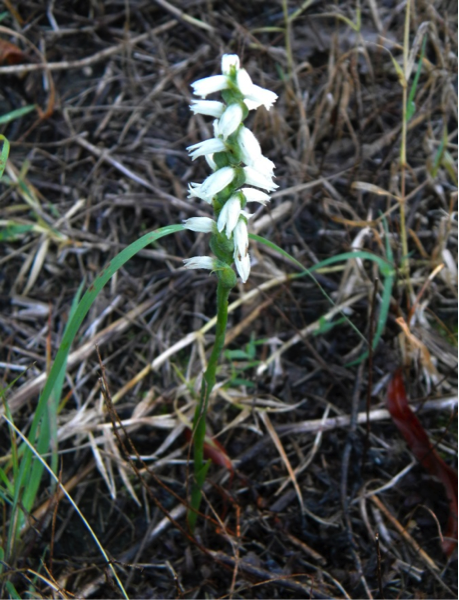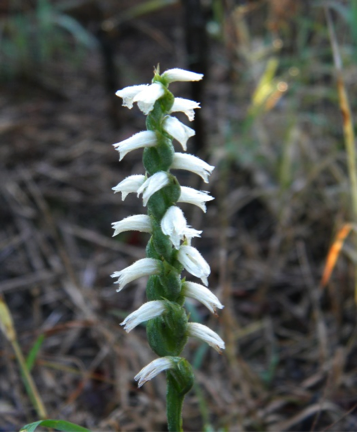Species of the Month, October 2014: Nodding Ladies’ Tresses
Note: This is the tenth post in our "Species of the Month" series, written by Park Ecologist Peter VanLinn. It's one of several 2014 initiatives meant to share knowledge we have about the Park with those who love it.
On September 26 and 27, Forest Park Forever worked with the Academy of Science – St. Louis to celebrate another biennial BioBlitz event, where more than 300 citizens joined over 20 science experts to inventory any living organisms they could find across the Park.
One of the big discoveries for the weekend was of a new plant species to Forest Park, Nodding Ladies’ Tresses. This is only one of the 36 species orchids known to the state of Missouri, but also one of the only orchids in the state known to be fragrant. It grows in moist, sandy soils along the waterway in the Park. Keep your eyes peeled as you are out using any of the waterfront trails throughout the Park because this fall blooming species is only 1 to 2 feet tall.
Nodding Ladies’ Tresses: (Spiranthes cernua)
- Scientific Name: Spiranthes cernua
- Common Name: Nodding Ladies' Tresses
- Plant Type: Perennial forb
- Species Family: Orchidaceae (Orchid family)
Forest Park Locations: Riparian corridor along the banks of the waterway.


Characteristics & Identification:
- Leaves: Basal, 2 to 6, linear and strap like with smooth margins, measuring up to 45 cm (17+ in.) in length and about 2.5 cm wide (1 in.). Leaves can appear absent at anthesis and cauline leaves are scale, up to 3 cm long (1.2 in.).
- Stem: Ariel stems up to 50 cm tall (19.7 in.), herbaceous and 3-5mm (< 0.2 in.) in diameter. Lower stem is glabrous while dense, short, glandular hairs form just below the flowering spikes.
- Flowers: Terminal twisted spike up to 12 cm (< 5 in.) long, light green and covered in glandular hairs. Flowers arranged as intertwined (2 to 4) double spirals, consist of 3 white sepals and 3 white petals, and are about 11 mm (0.43 in.) long. Each flower has a flaring crisp margin on the lip and curves downward, slightly nodding. This is one of the few orchids to have a fragrance. Blooms Aug. – Nov.
- Fruits: Nov. – Dec., seed capsules turning from green to brown.
- Seeds: Very small, brown, dust-like seeds that are wind-dispersed.
- Summer Leaf: Green
- Fall Leaf: Absent
- Bloom Color: White
- Bloom Time: August – November
- Fruit Color: Greed to Brown capsule
- Height: 9 – 45 cm
- Spread: 9 – 20 cm
- Exposure: Full to part sun
- Moisture: Medium to moist
- Soil & Climate: Moist sandy soil
- Growth Rate: Slow to establish
- Hardiness Zone: 5 to 9
- Attributes & Features Spiranthes cernua is a short perennial forb in the orchid family which contains over 15,000 plants, one of the largest plant families on the planet. However, only about 36 species of orchid grow in Missouri, as most of that plants in the orchid family grow in the Tropics. Spriranthes cernua is one of the more common orchids in Missouri as it seems to do well after disturbances like fire or mowing. This is one of the few orchids with a frangrace to it.
Ecosystem Connections: Native Range – Throughout the eastern U.S. from Maine to Florida and West to North Dakota and Texas. Nodding Ladies’ Tresses are aptly named for its slightly nodding flowers that bloom in fall. Orchids are famous for their diverse range of flower shapes which are adaptations for enabling certain types of pollination by various insects. The spiral pattern of ladies’ tresses is an adaptation that is thought to encourage pollination by bee species.
Culture: The common name “ladies’ tresses” arose because the spiral arrangement of the flowers resembles braided hair. It is thought that this name stuck because of the poetic and colorful description it provides for that plant characteristic.
Habitat and Conservation: Occurs in dry acidic glades, upland dry prairies, old fields, wet meadows, open stream valleys and thickets. Many of the orchids of Missouri occur in small populations and are declining due to changes to habitat, such as soil moisture, sun exposure, surrounding plant densities, and so on. Nodding Ladies Tresses’ have been believed to transplant poorly due to a required relationship with mychorrhizal fungi that may not exist in new planting sites.
Note: All information collected from the Online Field Guide at mdc.mo.gov, the Online Plantfinder at missouribotanicalgarden.org and the Online Plant Key at missouriplants.com.

